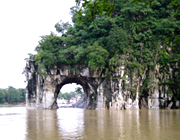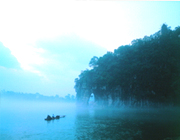Elephant Trunk Hill
 Lying at the place where Taohua (peach blossom) River meets Li River, with Guilin City on its northwest, Elephant Trunk Hill is regarded as the symbol of Guilin landscape. Originally named "Li Hill", "Yi Hill" and "Chenshui Hill", the hill has a history of 3.6 hundred million years. Resembling an elephant leisurely sucking water from the river with its long trunk, this hill is famous as Elephant Trunk Hill for hundreds of years.
Lying at the place where Taohua (peach blossom) River meets Li River, with Guilin City on its northwest, Elephant Trunk Hill is regarded as the symbol of Guilin landscape. Originally named "Li Hill", "Yi Hill" and "Chenshui Hill", the hill has a history of 3.6 hundred million years. Resembling an elephant leisurely sucking water from the river with its long trunk, this hill is famous as Elephant Trunk Hill for hundreds of years.
With an elevation of 200m, the hill towers 55m above the water, measuring 108m in length and 100m in width.
Moon-over-Water Cave
Between the trunk and the legs of the elephant is a cave, with 17 meters long, 9.5 meters wide and 12meters high, in the shape of a full moon, penetrating the hill from side to side. People named it "Moon-over-Water Cave". When the waters wave and the moonlight gleam, the scene is exceedingly enchanting. On the walls in and around this cave, over 70 inscriptions from the Tang and Song dynasties were found, praising the beauty of hills and water nearby.
Elephant Eye Cave
Climbing through the snaking stone path highway up to the hill, visitor will see another cave going through the hill, the Elephant Eye Cave. With a height of around 2 meters, the cave spans 5 to 10 meters in width, about 52 meters in length. It's so called for the  cave located right at the site for eyes. Through it visitors can overlook the beautiful scene of Guilin city.
cave located right at the site for eyes. Through it visitors can overlook the beautiful scene of Guilin city.
Puxian Pagoda
On top of the hill stands a pagoda named Puxian Pagoda. Built in the Ming dynasty (1368-1644), it looks like the handle of a sword. In and out of the cave are many carvings and inscriptions, the most well-known of which is a poem by Lu You (1125-1210), one of the four great poets of the Southern Song dynasty (1127-1279).